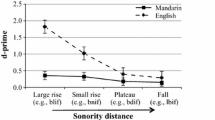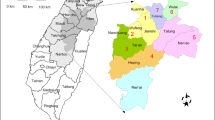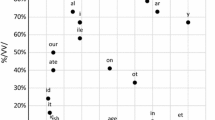Abstract
English words, when adapted into Japanese, show interesting asymmetries in the occurrence and non-occurrence of geminate consonants. One asymmetry can be found in minimal pairs like ‘stuff’ [stʌf] and ‘tough’ [tʌf]. Both have a lax vowel followed by /f/, but the former (with a CC onset) is borrowed into Japanese with a geminate consonant while the latter (with a C onset) is borrowed with no geminate consonant. The question is whether this difference is due to phonetic properties of the English coda consonant, particularly its durational properties, or to the different phonological onset structures of the source forms. To test these hypotheses, three judgment experiments were conducted. Experiment 1 used stimuli with excised onsets, created by deleting the initial consonant of CC-onset forms. The percentage of geminate judgments by Japanese listeners (hereafter, geminate judgment percentage) was significantly lower for the excised stimuli than for the original stimuli. Statistical analysis showed that the duration of the coda consonant relative to the preceding vowel (C/V) was not related to the geminate judgments. CC onsets elicited more than eight times as many geminate judgments as C onsets and excised onsets. Experiment 2 tested geminate judgments with four onset types: CCC, CC, C, and no onset. We found that, across all four onset types, none of the durational factors we tested accounted for the geminate judgment percentages, but the different onset structures did influence geminate judgments. One interesting result from Experiment 2 was that the geminate judgment percentage for CCC onsets was smaller than that for CC onsets. When CCC onsets are adapted, the loanword has either four or five moras, depending on whether or not a geminate occurs. Assuming the perceptual boundary hypothesis proposed by Kubozono and Ogawa (in: T. Oishi et al. (eds) Gendaikeitairon no choryu [Trends in modern morphology], 2004), we claim that native Japanese listeners prefer four-mora forms to five-mora forms when considering them as single words and that this preference influences the gemination patterns. Experiment 3 was conducted to test whether a tendency toward geminate judgments would be observed with stimuli in which the initial C of a complex onset was replaced by a CV sequence, and the results demonstrated such a tendency. We claim this is further evidence that phonological factors and not durational properties affect Japanese listeners’ geminate judgments.
Similar content being viewed by others
References
Boersma, Paul, and David Weenink. 2005. Praat: Doing phonetics by computer (version 5.2.16) [Computer program]. Retrieved from http://www.praat.org/.
Dupoux, Emmanuel, Kazuhiko Kakehi, Yuki Hirose, Christophe Pallier, and Jacques Mehler. 1999. Epenthetic vowels in Japanese: A perceptual illusion? Journal of Experimental Psychology: Human Perception and Performance 25: 1568–1578.
Fowler, Carol A. 1983. Converging sources of evidence on spoken and perceived rhythms of speech: Cyclic production of vowels in monosyllabic stress feet. Journal of Experimental Psychology: General 112: 386–412.
Fujisaki, Hiroya, and Miyoko Sugito. 1977. Onsei no butsuriteki seishitsu [Physical nature of the sound]. In Iwanami Koza: Nihongo 5, On’in [Iwanami lecture series Japanese 5], ed. S. Ono and T. Shibata, 63–106. Tokyo: Iwanami Shoten.
Hirata, Yukari, and Jacob Whiton. 2005. Effects of speech rate on the singleton/geminate distinction in Japanese. Journal of the Acoustical Society of America 118: 1647–1660.
Idemaru, Kaori, and Susan Guion-Anderson. 2010. Relational timing in the production and perception of Japanese singleton and geminate stops. Phonetica 67: 25–46.
Ihaka, Ross, and Robert Gentleman. 1996. R: A language for data analysis and graphics. Journal of Computational and Graphical Statistics 5: 299–314. Available from http://www.R-project.org.
Ishiwata Toshio, ed. 1990. Kihon gairaigo jiten [Basic loanword dictionary]. Tokyo: Tokyodo Publishing.
Ito, Kikuyo, and Winifred Strange. 2009. Perception of allophonic cues to English word boundaries by Japanese second language learners of English. Journal of the Acoustical Society of America 125: 2348–2360.
Kawagoe, Itsue, and Masako Arai. 2002. Shakuyogo niokeru sokuon [Consonant gemination in loanwords]. Onsei Kenkyu [Journal of the Phonetic Society of Japan] 6(1): 53–66.
Kono, Morio. 1997. Rizumu no chikaku to shinri [Psychology of rhythm perception]. In Akusento, intoneshon, rizumu to pozu [Accent, intonation, rhythm and pause], ed. Miyoko Sugito, 91–142. Tokyo: Sanseido.
Kubozono, Haruo. 1996. Syllable and accent in Japanese: Evidence from loanword accentuation. The Bulletin (Phonetic Society of Japan) 211: 71–82.
Kubozono, Haruo. 1999. Mora and syllable. In The handbook of Japanese linguistics, ed. Natsuko Tsujimura, 50–55. Malden: Wiley-Blackwell.
Kubozono, Haruo. 2006. Where does loanword prosody come from? A case study of Japanese loanword accent. Lingua 116: 1140–1170.
Kubozono, Haruo, and Shinji Ogawa. 2004. “Sutoraiki” wa naze “suto” ka? Tanshuku to tangobunsetsu no mekanizumu [Why is ‘strike’ shortened to ‘suto’ in Japanese? An analysis of word truncation and segmentation]. In Gendaikeitairon no choryu [Trends in modern morphology], ed. Tsuyoshi Oishi et al., 155–174. Tokyo: Kurosio Publishing.
Kubozono, Haruo, and Satoshi Ohta. 1998. Onsetsu kozo to akusento [Syllable structure and accent]. Tokyo: Kenkyusha.
Kubozono, Haruo, Junko Itô, and Armin Mester. 2008. Consonant gemination in Japanese loanword phonology. In Current issues in unity and diversity of languages. Collection of papers selected from the 18th international congress of linguists [CIL 18], ed. The Linguistic Society of Korea, 953–973. Seoul: Dongam Publishing Co.
Kubozono, Haruo, Hajime Takeyasu, and Mikio Giriko. 2011. Nihongo sokuon no ‘ichi koka ni tsuite’ [‘Positional effect’ of geminates in Japanese]. Paper presented at the international workshop on geminate consonants (GEMCON) held at Kobe University.
Ohye, Saburo. 1967. Gairaigochu-no sokuon ni kansuru ichi-kosatsu [A study on geminates in loanwords]. Onsei no kenkyu [Journal of the Phonetic Society of Japan] 13: 111–121.
Otaka, Hiromi. 2009. Phonetics and phonology of moras, feet, and geminate consonants in Japanese. Lanham: University Press of America.
Prince, Alan, and Paul Smolensky. 1993. Optimality theory: Constraint interaction in generative grammar. Rutgers University Center for Cognitive Science Technical Report 2.
Sanseido Henshujo. 1987. Konsaisu gairaigo jiten [Concise loanword dictionary]. 4th ed. Tokyo: Sanseido.
Sanseido Henshujo. 2005. Konsaisu katakanago jiten [Concise dictionary of katakana words]. Tokyo: Sanseido.
Takagi, Naoyuki, and Virginia Mann. 1994. Perceptual basis for the systematic phonological correspondences between Japanese loan words and their English source words. Journal of Phonetics 22: 343–356.
Takeyasu, Hajime. 2009. On’inronteki yuhyosei to sono onseigakuteki kiban [Phonological markedness and its phonetic basis]. Ph.D. dissertation, Kobe University.
Vance, Timothy J. 1987. An introduction to Japanese phonology. Albany: State University of New York Press.
Vance, Timothy J. 2008. The sounds of Japanese. Cambridge: Cambridge University Press.
Author information
Authors and Affiliations
Corresponding author
Rights and permissions
About this article
Cite this article
Kawagoe, I., Takemura, A. Geminate judgments of English-like words by Japanese native speakers: differences in the borrowed forms of “stuff” and “tough”. J East Asian Linguist 22, 307–337 (2013). https://doi.org/10.1007/s10831-013-9105-3
Received:
Accepted:
Published:
Issue Date:
DOI: https://doi.org/10.1007/s10831-013-9105-3




